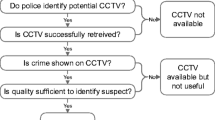Abstract
This article considers the question of whether it is meaningful to speak of privacy rights in public spaces, and the possibility of such rights framing the basis for regulating or restricting the use of surveillance technologies such as closed circuit television (CCTV). In particular, it responds to a recent article by Jesper Ryberg that suggests that there is little difference between being watched by private individuals and CCTV cameras, and instead argues that state surveillance is qualitatively different from (and more problematic than) surveillance by ‘lonely old ladies’.
Similar content being viewed by others
Notes
Going further, one could argue that Mrs. Aremac is in fact the most benign choice of observer, and that were we to chose a different person—say a man who derives sexual gratification from spying on his neighbours—it is relatively easy to imagine a situation in which we would regard their observation as an infringement on our expectation of privacy. Furthermore, being able to know which of the two (Mrs. Aremac or the peeping tom) is the one watching us from a nearby window may make all the difference when deciding whether we feel our privacy has been invaded.
Having said this, the fact that most CCTV cameras can and do record information is in practice extremely important in terms of privacy. Although the focus of my original argument was on whether simply being observed can constitute a violation of privacy, in practice a large part of the threat posed by CCTV derives from the fact that the images collected by such cameras can be stored and disseminated with ease.
This is a point that I believe is implicit yet clear in my original article—i.e. that when we talk of a right to privacy in the context of surveillance, we envisage a right that can be asserted by the individual against the state. Of course, there may also be circumstances in which such a right might be enforceable against certain private organisations, such as companies operating surveillance cameras in semi-private spaces such as shopping malls. This is an even more complicated situation than the one currently under discussion, and I have not attempted to deal with it here. It could be argued, however, that being watched by a private organisation is more like being placed under surveillance by the state than being observed by Mrs. Aremac, at least in terms of the implications for individual privacy. For example, a private company may, on the basis of information gleaned from CCTV observation, decide to exclude a person from its premises, or refuse to sell them goods and services. Equally, it may have the capacity to share information about that person gathered by CCTV with other organisations, and possibly even the state.
In arguing that the use of CCTV in public spaces has implications for privacy, I am conscious of the fact that one needs to be able to provide a coherent account of why privacy is valuable in such contexts. While I do attempt to explain why privacy matters in public spaces in my original article, for the purposes of this reply it is simply enough to note that the presence of CCTV cameras can harm various kinds of privacy interests. For a more fulsome theory of privacy in public, see Goold (2006), and Slobogin (2002).
References
Goold, Benjamin J. 2002. Privacy rights and public spaces: CCTV and the problem of the “Unobservable Observer”. Criminal Justice Ethics 21: 21–27.
Goold, Benjamin J. 2006. Open to all? Regulating open street CCTV and the case for “Symmetrical Surveillance”. Criminal Justice Ethics 25: 3–17.
Ryberg, Jesper. 2007. Privacy rights, crime prevention, CCTV, and the life of Mrs. Aremac. Res Publica 13: 127–143.
Slobogin, Christopher. 2002. Public privacy: Camera surveillance of public places and the right to anonymity. Mississippi Law Journal 72: 213–299.
Author information
Authors and Affiliations
Corresponding author
Rights and permissions
About this article
Cite this article
Goold, B. The Difference Between Lonely Old Ladies and CCTV Cameras: A Response to Ryberg. Res Publica 14, 43–47 (2008). https://doi.org/10.1007/s11158-008-9045-3
Published:
Issue Date:
DOI: https://doi.org/10.1007/s11158-008-9045-3




